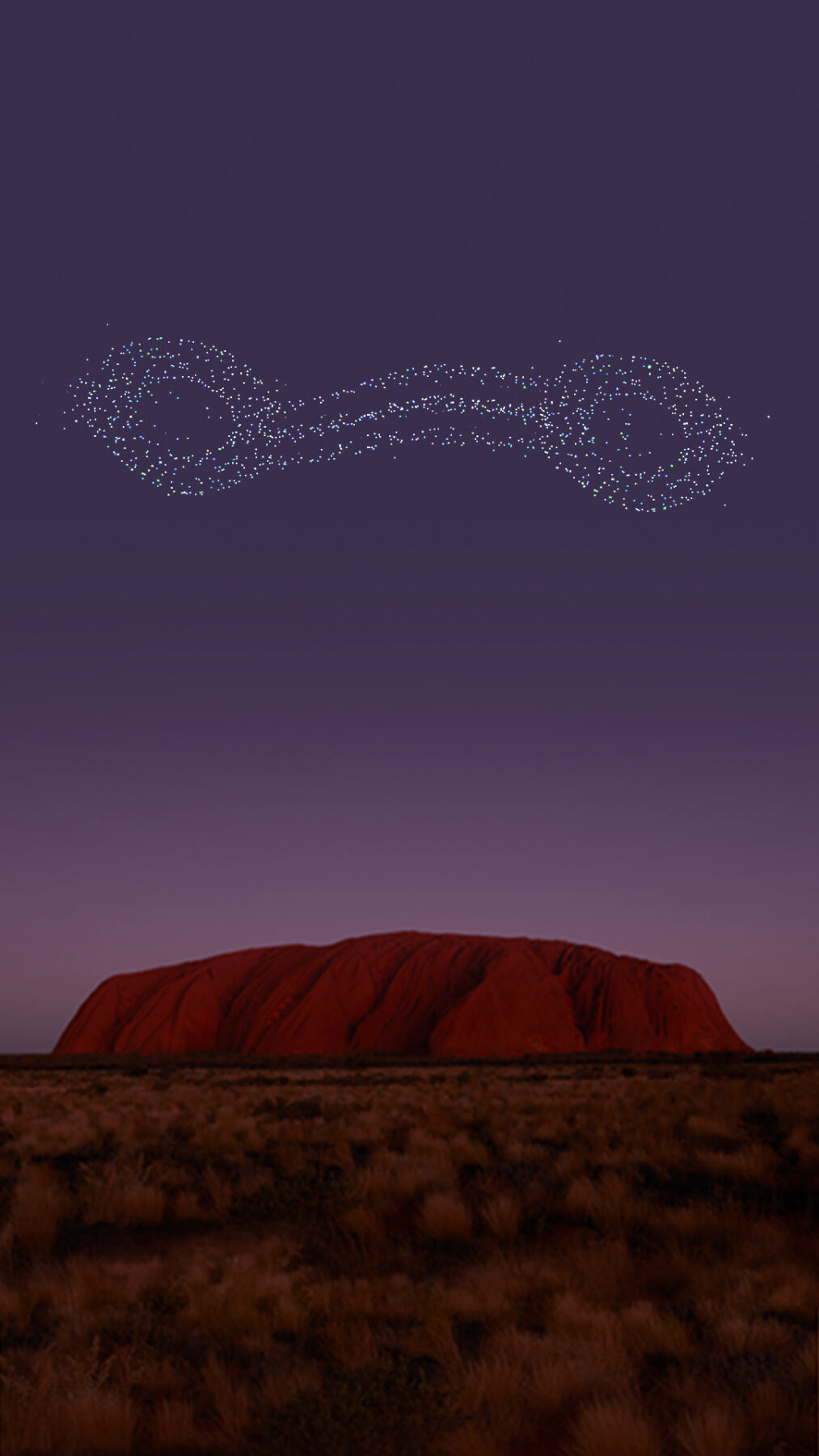Indigenous art moves into the future

Drones, lasers and lights dance across a liquorice sky as the Aṉangu of Uluru tell a story of creation in a way they never have before. Wintjiri Wiru is an impressive blend of technology, art and Indigenous culture, and brings to life a chapter of the Mala ancestral story, from Kaltukatjara (Docker River) to Uluru. It’s a dramatic yet peaceful experience; spiritual yet modern.
With Uluru as an off-centre backdrop, soft lights and a haunting soundtrack introduce Outback tourists to an ancient story beginning with the Mala (rufous hare-wallaby) People. Projections of the wallaby scurry across yellowing desert spinifex and mulga. Glowing footprints of an evil spirit sneak across the sky. A cluster of drones majestically transforms into a bird, and then a devil dog portrayed so powerfully the crowd is silenced.
Launched in May, Wintjiri Wiru features more than 1200 drones and feels more like a performance than a show. It also features important inma (songs) that have been passed down from generation to generation. It’s the first time a show of this magnitude has been performed on a regular basis anywhere in the world. As far as a cultural art experience goes, Wintjiri Wiru will undoubtedly capture the attention of Australia and the world in an even bigger way than the illuminated installation Field of Light has since 2016. But this story is about more than being entranced by pretty lights; it’s about more than making another tourist buck. This is a story about preserving the world’s oldest surviving living culture by sharing it in a modern, exciting and accessible way.
A story as old as time
Rene Kulitja is one of 10 senior Aṉangu from Kaltukatjara and Mutitjulu who worked in close collaboration with Voyages Indigenous Tourism Australia and light artist Bruce Ramus on Wintjiri Wiru. For her, the twice-nightly storytelling experience is a way to connect people from all walks of life with Tjukurpa (Aṉangu creation stories and lore).
“When we saw the result of all that work we were quite overwhelmed, we felt immensely proud and happy,” Rene says on behalf of the Anangu Consultation Group.
“We had no experience in anything involving those kinds of technologies and lights in the past but how we saw it bring things to life for us was amazing, and that it came from our Tjukurpa, from our story, from our understanding of the world.”
Denise Brady, another Aṉangu senior, adds: “With the light show… I see the colours, the picture, the pattern and hear the voices of our grandparents still talking…”
The Aṉangu are proud to be sharing a small part of their story, no matter the medium, and believe it will help ensure a viable and culturally rich future for Indigenous children. Peter Mitchell, also of the Anangu Consultation Group, says they are telling the same fundamental stories passed down by their older brothers and fathers.
“…With this light show it’s going to be the same… the next generations will follow from that story and the way we’ve done this thing, and they’ll continue into the future… and they will be able to think to themselves and see what their parents have left for them, what they’ve done for them,” Peter says.
“They will think ‘we know we’re not going backwards, we are going forwards into the future but the way we go forward is going to be with strength and in the proper way that will do our parents and grandparents proud’.”
An artful marriage
Wintjiri Wiru is a dazzling new experience that instead of taking away from traditional Indigenous art, sits alongside it, adding another dimension. Indigenous guide Sammy Wilson, also part of the working group, hopes the show will encourage visitors to head out on the Mala Walk around the base of Uluru. While following the red-earth track, Sammy stops at caves to point out rock art and tjukuritja (physical evidence) used for teaching youngsters, and visitors. He says Wintjiri Wiru ties in well with their story and compliments other Indigenous tourism experiences – walking tours, art gallery visits, bush tucker talks and more.
The Aṉangu are eager to invite visitors to expand their understanding of Tjukurpa, and they express hope Wintjiri Wiru will encourage people to see more than Uluru.
“Tourists have been coming to this Country for a long time but it’s taken us a long time to develop something such as this,” says Rene, who’s also an internationally acclaimed artist. “One thing that would be really great to come out of it is for people to want to see more of our Country beyond just here (Uluru), (to come) out to other parts of the country with us.”
She says they have created Wintjiri Wiṟu for the next generation and adds: “For all the people of whatever colour they are, come together, be as one. Go into the future together.”

Technology & environment
– Acoustic testing has been carried out to ensure the noise of the show does not negatively impact upon the desert wildlife, and testing will be ongoing.
– The drones are stored in temperature-controlled and dust-proof housing to protect them from the desert climate.
– Solar power was considered but the disruption to the environment regarding installation was too great. It will continue to be considered into the future though, as solar technology advances.
– The original show site was moved in order to protect a population of endangered desert skinks.
– The Wintjiri Wiru viewing platform has been built with sustainable timber and above the desert for minimal disturbance to the landscape.
Image credit: Voyages Indigenous Tourism Australia. Anangu hold the Mala story, from Kaltukatjara to Uluru, through a drone, sound and light show designed and produced by RAMUS.
To learn more about Wintjiri Wiru, visit ayersrockresort.com.au.
*All quotes from the Anangu Working Group have been translated.





